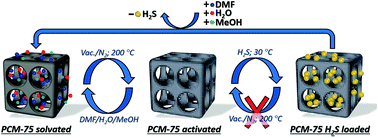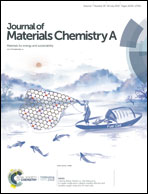Phosphonium zwitterions for lighter and chemically-robust MOFs: highly reversible H2S capture and solvent-triggered release†
Abstract
The tetrahedral zwitterion of tetrakis(p-carboxyphenyl) phosphonium is structurally analogous to a family of ligands with C or Si cores that have found great utility in the preparation of stable MOFs. However, the central P(V)+ core in this molecule reduces the formal ligand charge, resulting in a PR43− tetra(carboxylate) species. This new strategy allows for the formation of lighter MOFs by incorporation of less metal, which cannot be accessed using conventional ligands. The phosphonium zwitterion is stable under hydrothermal synthesis conditions; it spontaneously crystallizes from hot DMF to give a metal-free and infinitely porous ionic hydrogen-bonded organic framework, which is stable in water and organic solvents. We demonstrate how direct hydrothermal treatment of the ionic framework in the presence of In(NO3)3 yields a new charge-neutral In(III) MOF with diamondoid topology. By comparison, solvothermal reaction in the presence of Mg(NO3)2 yields a chemically-robust MOF with permanent 3D porosity. The Mg(II)-based MOF displays water adsorption properties with an estimated ΔHads of −63.5 kJ mol−1 and a maximum uptake of 38.9 wt% at 30 °C. This exceptionally stable material also showed highly reversible H2S sorption with a capacity of ∼8 mmol g−1, and solvent-triggered H2S release.



 Please wait while we load your content...
Please wait while we load your content...
